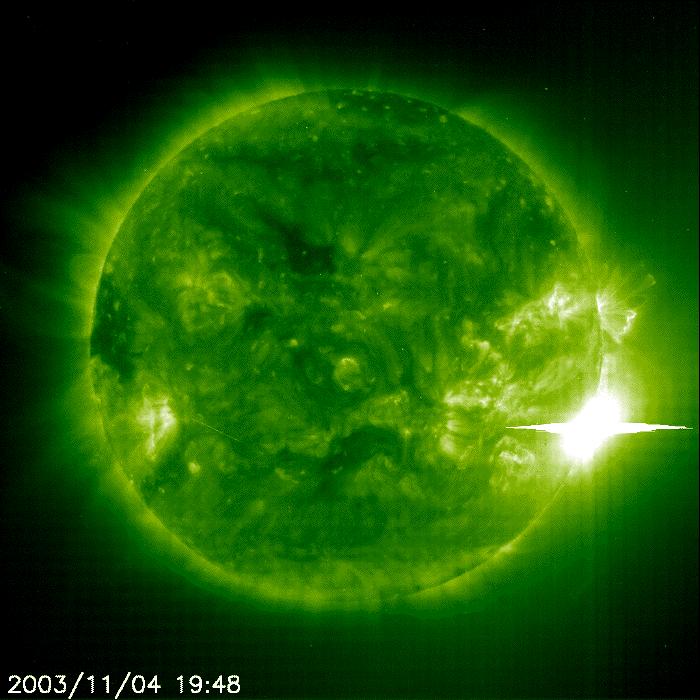| SPACE TODAY ONLINE COVERING SPACE FROM EARTH TO THE EDGE OF THE UNIVERSE | ||||||||||
| COVER | SOLAR SYSTEM | DEEP SPACE | SHUTTLES | STATIONS | ASTRONAUTS | SATELLITES | ROCKETS | HISTORY | GLOBAL LINKS | SEARCH |
The Sun:
Halloween Storm Surge Shocks Earth
Earthlings were fortunate in 2003. Our planet's strong magnetic field shielded us from the full brunt of what scientists know as the Halloween Storms on the Sun. At the end of the year, seven major solar outbursts jolted Earth's upper atmosphere, setting records for extreme space weather.
The largest flare ever seen on the Sun
click to enlarge SOHO/EIT ESA & NASA image
Here's why things could have been much worse. The space-weather records set in the fall of 2003 included:The record solar storms that erupted in late October and early November, 2003, particularly the largest X-ray flare ever recorded, threatened power systems on the planet's surface and communications and weather satellites in orbit above Earth.
- The largest X-ray solar flare ever recorded
- The fastest-moving solar storm ever. It splashed over us at nearly 6 million mph.
- The hottest storm ever. It was tens of millions of degrees as it doused Earth.
In fact, the solar blasts caused power outages in Sweden, disturbed airplane routes around the world, and damaged 28 satellites, ending the service life of two.
Earth Satellites. Satellites are part of daily life. They are used for communications, weather forecasting, navigation, observing land, sea and air, other scientific research, and military reconnaissance. Men and women live and work aboard manned satellites – space shuttles and space stations.
Hundreds of satellites work for us in orbit above our planet, including 150 commercial communications satellites. Large doses of electrically charged solar particles can shock those satellites and even kill them.
Fortunately, power companies and satellite operators have begun to pay attention to space weather forecasts in recent years. Hearing warnings this time, they were able to protect their more vulnerable systems. The Halloween Storms of 2003 did not set a record for satellite damage.
Beyond Earth. The waves of solar energy blasted away from the Sun by the flares didn't stop at Earth. They went beyond to burn out the radiation monitor aboard the Global Surveyor spacecraft orbiting Mars. That instrument had been tracking the radiation future explorers might encounter on trips to the Red Planet. And beyond Mars near the planet Saturn, the Cassini spacecraft measured the intense energy from the Sun.
Months later, the energy from the storm reached beyond Pluto's orbit to the edge of the Solar System, washing over the Voyager spacecraft.
Solar Cycles. Scientists found the Halloween Storms intriguing because they came some three years after the peak of the most recent sunspot cycle.
Sunspot activity varies on the face of the Sun in eleven-year cycles. As the number of sunspots increases, so does the solar storm activity, which can sometimes leave the Earth's magnetic field shaking as though a giant hurricane were approaching.
A flare is a brilliant outbreak in the Sun's upper atmosphere at or near a sunspot. It is an explosive release of large amounts of electromagnetic radiation and huge quantities of charged particles.
Sun and Sunspots Index Page Learn More about Our Sun and Sunspots and Their Effects on Earth
Read more Space Today Online stories about the Solar System Star: The Sun Inner Planets: Mercury Venus Earth Mars Outer Planets: Jupiter Saturn Uranus Neptune Pluto Other Bodies: Moons Asteroids Comets Beyond: Pioneers Voyagers
Top of this page Solar System index Space Today Online cover
Copyright 2004 Space Today Online E-Mail
